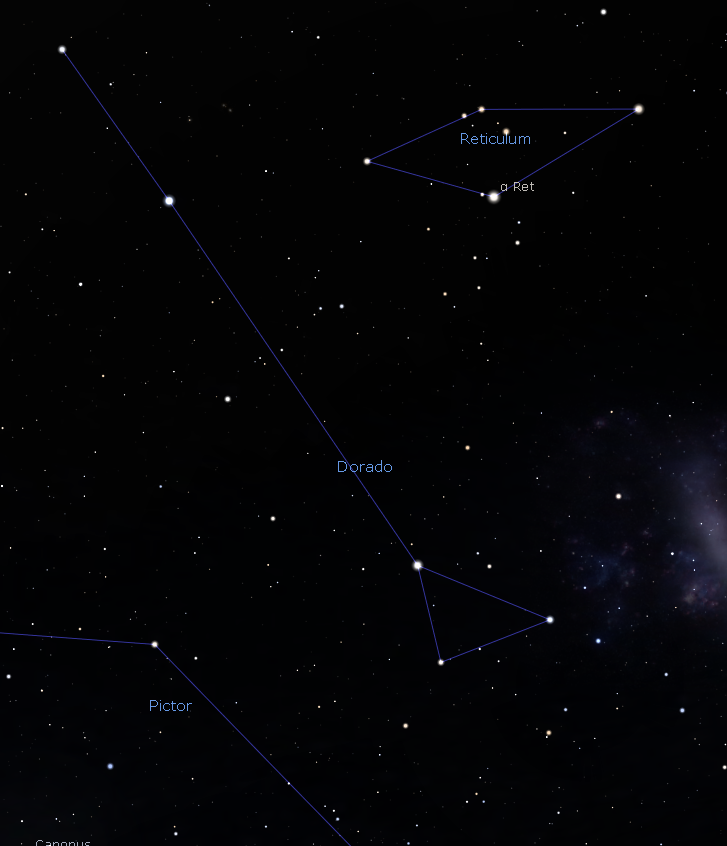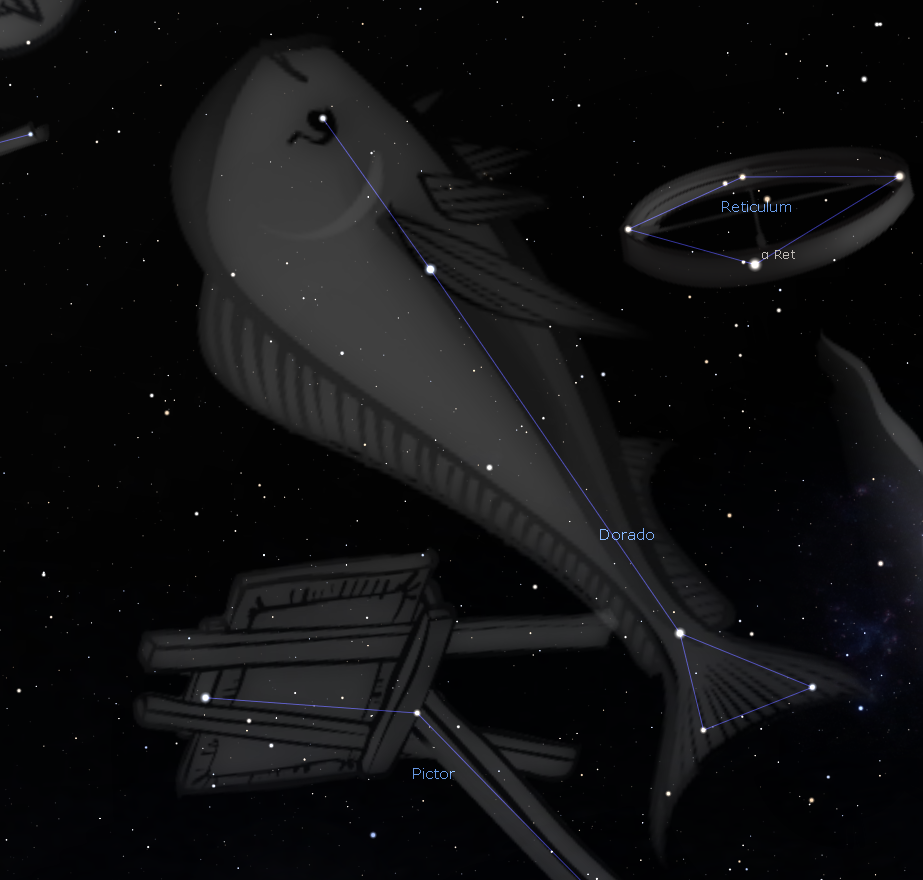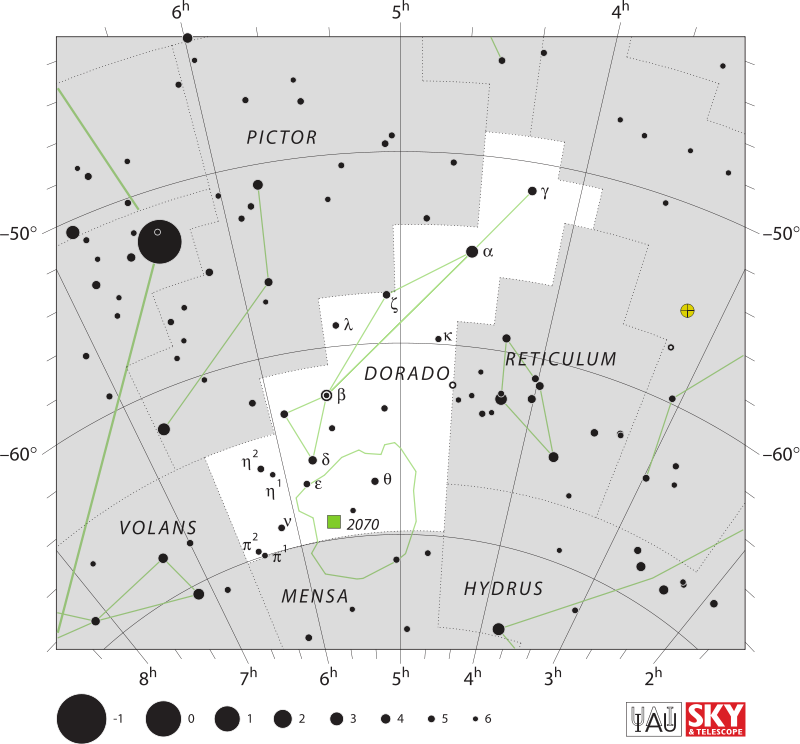|
The constellation Dorado may be found in the southern sky. It was first named in the late 16th century and is now one of the eighty-eight constellations that make up the modern sky. Its name is derived from the dolphinfish (Coryphaena hippurus), which is also known as the dorado in Spanish and has been represented as a swordfish. The Large Magellanic Cloud is mostly contained in the constellation Dorado, with the remainder in the constellation Mensa. This constellation also contains the South Ecliptic Pole.
Even though the name Dorado is Spanish, astronomers use the Latin genitive form Doradus when identifying its stars; it is viewed (together with the nearby asterism Argo Navis) as a feminine proper name of Greek origin ending in - (like Io, Callisto, or Argo), which all have a genitive ending. |
Deep-sky Objects
Dorado is rich in deep sky objects because it contains a portion of the Large Magellanic Cloud (LMC), with a diameter of 25,000 light-years and 179,000 light-years, is a satellite galaxy of the Milky Way Galaxy. Its gravitational interactions with the bigger Milky Way have distorted it. It was home to SN 1987A in 1987, the first supernova of the year and the closest since 1604. [5] Over 10,000 million stars make up this 25,000-light-year-wide galaxy. (Ridpath & Tirion 2017).
N 180B – Emission Nebula in the Large Magellanic Cloud
NGC 1566 - spiral galaxy. It gives its name to the NGC 1566 (Group of galaxies).
NGC 1755 - Globular Cluster.
NGC 1763 - bright Emission Nebula associated with three type B stars.
NGC 1820 - Open Cluster.
NGC 1850 - Globular Cluster.
NGC 1854 - Globular Cluster.
NGC 1869 - Open Cluster.
NGC 1901 - Open Cluster.
NGC 1910 - Open Cluster.
NGC 1936 – Emission bright nebula and is one of four NGC objects near NGC 1929 (Open Cluster), NGC 1934 (Emission Nebula) and NGC 1935 Emission Nebula).
NGC 1978 is an open cluster.
NGC 2002 is an open cluster.
NGC 2014 is a red emission nebula.
NGC 2020 is an HII region surrounding a Wolf–Rayet star.
NGC 2027 is an open cluster.
NGC 2032 - Seagull Nebula - Emission Nebula complex (Containing 4 NGC catalogue objects - NGC 2029 (Emission Nebula), NGC 2032 (Emission Nebula), NGC 2035 (Emission Nebula) and NGC 2040 (Open Cluster)).
NGC 2080 – Ghost Head Nebula – Emission Nebula
NGC 2070 – Open Cluster within an HII Region in the LMC
NGC 2164 – Globular Cluster
N44 – Emission Nebula (Containing a super bubble structure)
Main stars - 3
Bayer stars - 14
Stars with planets - 5
Stars brighter than magnitude 3.00 - 0
Stars within 32 ly - 0
Bordering
constellations
Dorado is rich in deep sky objects because it contains a portion of the Large Magellanic Cloud (LMC), with a diameter of 25,000 light-years and 179,000 light-years, is a satellite galaxy of the Milky Way Galaxy. Its gravitational interactions with the bigger Milky Way have distorted it. It was home to SN 1987A in 1987, the first supernova of the year and the closest since 1604. [5] Over 10,000 million stars make up this 25,000-light-year-wide galaxy. (Ridpath & Tirion 2017).
N 180B – Emission Nebula in the Large Magellanic Cloud
NGC 1566 - spiral galaxy. It gives its name to the NGC 1566 (Group of galaxies).
NGC 1755 - Globular Cluster.
NGC 1763 - bright Emission Nebula associated with three type B stars.
NGC 1820 - Open Cluster.
NGC 1850 - Globular Cluster.
NGC 1854 - Globular Cluster.
NGC 1869 - Open Cluster.
NGC 1901 - Open Cluster.
NGC 1910 - Open Cluster.
NGC 1936 – Emission bright nebula and is one of four NGC objects near NGC 1929 (Open Cluster), NGC 1934 (Emission Nebula) and NGC 1935 Emission Nebula).
NGC 1978 is an open cluster.
NGC 2002 is an open cluster.
NGC 2014 is a red emission nebula.
NGC 2020 is an HII region surrounding a Wolf–Rayet star.
NGC 2027 is an open cluster.
NGC 2032 - Seagull Nebula - Emission Nebula complex (Containing 4 NGC catalogue objects - NGC 2029 (Emission Nebula), NGC 2032 (Emission Nebula), NGC 2035 (Emission Nebula) and NGC 2040 (Open Cluster)).
NGC 2080 – Ghost Head Nebula – Emission Nebula
NGC 2070 – Open Cluster within an HII Region in the LMC
NGC 2164 – Globular Cluster
N44 – Emission Nebula (Containing a super bubble structure)
Main stars - 3
Bayer stars - 14
Stars with planets - 5
Stars brighter than magnitude 3.00 - 0
Stars within 32 ly - 0
Bordering
constellations
- Caelum
- Horologium
- Reticulum
- Hydrus
- Mensa
- Volans
- Pictor


